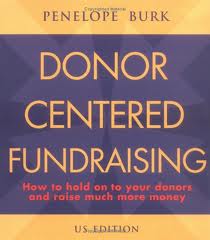 Welcome to O.D. Fridays at DonorDreams blog. Every Friday for the foreseeable future we will be looking at posts from John Greco’s blog called “johnponders ~ about life at work, mostly” and applying his organizational development messages to the non-profit community.
Welcome to O.D. Fridays at DonorDreams blog. Every Friday for the foreseeable future we will be looking at posts from John Greco’s blog called “johnponders ~ about life at work, mostly” and applying his organizational development messages to the non-profit community.
In a post titled “People-Service-Profit,” John talks about the impact that Federal Express’ corporate philosophy of People-Service-Profit has on it employees . . . which in turn has an effect on customer service and loyalty . . . which ultimately is reflected on the bottom line in profit
When reading John’s blog post this week, I immediately had two thoughts, which I will address below in two different sections.
Non-profit culture
People who work for non-profit organizations are different. In my experience, they aren’t motivated by the same things as their for-profit counterparts. Here are just a few examples of what I’ve seen people on the frontline of the non-profit sector do:
- They often agree to work for less money than they otherwise might earn working in the for-profit sector.
- I’ve seen non-profit employees work longer hours than they’re asked (or authorized to do). I’ve even seen hourly employees fudge their timesheet in order to avoid overtime (e.g. they get in trouble for working unauthorized time . . . overtime isn’t part of most agency’s budgets).
- I’ve seen program assistants purchasing supplies for their programs using their personal money because there isn’t enough agency funding to do so.
 The point I’m trying to make is that most non-profit organizations have built a culture that revolves around THE CLIENT. This focal point is so intense that ideas threatening to shift that focus are often seen as heresy.
The point I’m trying to make is that most non-profit organizations have built a culture that revolves around THE CLIENT. This focal point is so intense that ideas threatening to shift that focus are often seen as heresy.
While many people see a client-focused philosophy as altruistic, there can be a cost to this kind of corporate philosophy.
- Low employee morale
- Burnout
- Cynicism
- Poor staff cohesion
Another significant negative effect of this philosophy is “The Nonprofit Starvation Cycle”. I talked about this phenomenon in a previous “DonorDreams: O.D. Fridays” post on July 26, 2013 titled “Is your non-profit only living for today? Then you need Picasso!”
In the Picasso post, I describe how senior leadership and board volunteers are blinded by the agency philosophy of CLIENT FIRST, which results in zero funding important organizational capacity building expenditures. The end result is a non-profit that has no capacity and starves itself out of business.
Heck, in yesterday’s post about budgeting, I confessed that when I was an executive director, my finance committee once convinced me to eliminate donor newsletters from the budget in order to balance it. Ugh . . . while this was done in the name of putting the CLIENT FIRST, the result was putting the donor second (which is the person who needs to see ROI on their investment if they are going to renew their support). How did THAT make any sense?
So, let’s jump back to John’s post about company philosophy and FedEx.
If you are an executive director or someone who supervises staff, you should click-through and read the 10 bullet points located in the middle of John’s post. After reading those FedEx examples of how managers should treat their employees, I encourage you to complete the exercise described in the paragraph after the list.
It likely will be an eye-opening experience for you.
The Loyalty Effect
 I suspect many non-profit people who are reading today’s post are probably still not convinced that a CLIENT FIRST philosophy can be damaging.
I suspect many non-profit people who are reading today’s post are probably still not convinced that a CLIENT FIRST philosophy can be damaging.
More than a year ago, I wrote a week long blog series focused on “The Loyalty Effect: The Hidden Force Behind Growth, Profits, and Lasting Value,“ which is a book written by Frederich Reichheld. I mostly focused on translating some of his business themes into resource development messages.
However, one of Reichheld’s bigger points is how employee loyalty drives customer loyalty, which turns into profit on the bottom line.
If you are still one of those skeptics when it comes to this post, look at it from this perspective . . .
Many of your clients have “special relationships” with your staff. In fact, if you surveyed your clients, I suspect they would say they come to your agency primarily because of that relationship and secondarily because of your services. I know for a fact this was true for the kids using the programs at my former agency.
So, investing in your employees results in their retention and loyalty. This in turn keeps your customers coming back, which in turn drives impact and program results. When you communicate this impact (e.g. ROI) to donors, it improves your donor loyalty rates and you raise more money.
Please don’t misinterpret me here.
I am NOT suggesting you shouldn’t strive to make your clients happy and provide them with the best possible programming. However, I am saying the non-profit sector needs to take a page out of FedEx’s book and figure out how to invest in its people. It will make a huge difference in so many different ways!
Putting your employees first IS putting your customers first because your employees will put the customer first especially if your organizational values drive them to do so.
If you have some time this morning, I also encourage you to jump in the “way back machine” and check out that six part blog series about donor loyalty as it relates to some of Reichheld’s loyalty principles:
- A dog’s world: An introduction
- A dog’s world: Part 1 of 5
- A dog’s world: Part 2 of 5
- A dog’s world: Part 3 of 5
- A dog’s world: Part 4 of 5
- A dog’s world: Part 5 of 5
Want to change? Where to start?
If this post has you thinking about creating a different company culture, you may want to check out a post by Inc.com titled “How to Create a Company Philosophy“. It is definitely worth the click! 😉
Did you click-through and read John’s 10 bullet points? If so, how well did your agency do? What are you doing to invest in your employees? Is your organization avoiding the starvation cycle? If so, how are you making the case for investments in capacity building? Have you ever correlated your employee turnover to client turnover to donor turnover? If so, what have you found? Please scroll down and share your thought and experiences in the comment box below.
Here’s to your health!
Erik Anderson
Founder & President, The Healthy Non-Profit LLC
www.thehealthynonprofit.com
erik@thehealthynonprofit.com
http://twitter.com/#!/eanderson847
http://www.facebook.com/eanderson847
http://www.linkedin.com/in/erikanderson847

 The following is a thumbnail sketch of what my process looked like:
The following is a thumbnail sketch of what my process looked like: I am not suggesting that my process is the right way to put a non-profit budget together. However, I do believe strongly in the following few budget construction principles:
I am not suggesting that my process is the right way to put a non-profit budget together. However, I do believe strongly in the following few budget construction principles: You know what Douglas Adams says (according to
You know what Douglas Adams says (according to  When I look at my email inbox, I do a lot of scanning. I first look at the names of people who sent me something. As I do this, I am deleting anything that vaguely looks like spam or advertising. I don’t even open it. After this first purge, I re-visit those who are left standing and start looking at subject lines. I’m essentially trying to prioritize what I should open first versus leave for later when I have more time. And when I say “leave for later,” it could be days or weeks later.
When I look at my email inbox, I do a lot of scanning. I first look at the names of people who sent me something. As I do this, I am deleting anything that vaguely looks like spam or advertising. I don’t even open it. After this first purge, I re-visit those who are left standing and start looking at subject lines. I’m essentially trying to prioritize what I should open first versus leave for later when I have more time. And when I say “leave for later,” it could be days or weeks later. Every year, it seems like one of the charities I support is celebrating some kind of anniversary or milestone. Most of the time, it relates to the age of the organization, and it is typically a milestone like 25, 50, 75 or 100 years of existence. Sometimes it is a different kind of anniversary, where they’re celebrating a board member’s years of service or the age of something physical like a building. Regardless of the opportunity to celebrate, a fundraising solicitation is never far behind; however, anniversary celebrations can be so much more than just putting your hand out.
Every year, it seems like one of the charities I support is celebrating some kind of anniversary or milestone. Most of the time, it relates to the age of the organization, and it is typically a milestone like 25, 50, 75 or 100 years of existence. Sometimes it is a different kind of anniversary, where they’re celebrating a board member’s years of service or the age of something physical like a building. Regardless of the opportunity to celebrate, a fundraising solicitation is never far behind; however, anniversary celebrations can be so much more than just putting your hand out. A few weeks ago, I started getting email and snail-mail announcing the 100th anniversary of the
A few weeks ago, I started getting email and snail-mail announcing the 100th anniversary of the  For example . . .
For example . . . As with most things in this world, there are different schools of thought on different things. While working with a client recently, I was reminded of the two camps that non-profit professionals tend to fall into when it comes to writing vision statements. So, I thought it would be fun this morning to explore both perspectives.
As with most things in this world, there are different schools of thought on different things. While working with a client recently, I was reminded of the two camps that non-profit professionals tend to fall into when it comes to writing vision statements. So, I thought it would be fun this morning to explore both perspectives. Welcome to O.D. Fridays at DonorDreams blog. Every Friday for the foreseeable future we will be looking at posts from John Greco’s blog called “
Welcome to O.D. Fridays at DonorDreams blog. Every Friday for the foreseeable future we will be looking at posts from John Greco’s blog called “ One of the pre-test questions that tends to trip people up is whether or not the board has a responsibility to “oversee the CEO“. Believe it or not, it isn’t uncommon for one-quarter to one-third of board volunteers to say “NO“.
One of the pre-test questions that tends to trip people up is whether or not the board has a responsibility to “oversee the CEO“. Believe it or not, it isn’t uncommon for one-quarter to one-third of board volunteers to say “NO“. So, maybe you don’t know where to start?
So, maybe you don’t know where to start? I was reviewing some old non-profit board governance material this morning and came across a document talking about “trends in non-profit governance“. In other words, the person who wrote that paper thought s/he was able to predict the future. Of course, this document was written more than 10 years ago, which got me thinking it might be fun to review some of their trends and determine where they were right or wrong.
I was reviewing some old non-profit board governance material this morning and came across a document talking about “trends in non-profit governance“. In other words, the person who wrote that paper thought s/he was able to predict the future. Of course, this document was written more than 10 years ago, which got me thinking it might be fun to review some of their trends and determine where they were right or wrong.
 A few months ago, I had a horrible experience with my favorite airline. Long story short . . . delay, delay, delay, delay, loaded on the plane, equipment malfunction, delay, delay and finally up-up-and-away. A whole day was lost. However, in that catastrophe, I was able to learn something about Twitter and the new age of customer service. In the last few weeks, I’ve been reminded of this experience when two bloggers talked about Twitter. So, I thought I’d we’d look Twitter a little more closely today, especially as it relates to non-profit organizations.
A few months ago, I had a horrible experience with my favorite airline. Long story short . . . delay, delay, delay, delay, loaded on the plane, equipment malfunction, delay, delay and finally up-up-and-away. A whole day was lost. However, in that catastrophe, I was able to learn something about Twitter and the new age of customer service. In the last few weeks, I’ve been reminded of this experience when two bloggers talked about Twitter. So, I thought I’d we’d look Twitter a little more closely today, especially as it relates to non-profit organizations. I am on Twitter every day. I’m not there very long. I’m not a Twitter expert. I’m sure that I am doing lots and lots wrong in the eyes of social media experts. However, I do see lots of content and most of those who I’m following are non-profit organizations.
I am on Twitter every day. I’m not there very long. I’m not a Twitter expert. I’m sure that I am doing lots and lots wrong in the eyes of social media experts. However, I do see lots of content and most of those who I’m following are non-profit organizations. This is a tough question to answer because I suspect it may vary slightly from agency-to-agency. However, some of the better non-profit organizations are tweeting the following:
This is a tough question to answer because I suspect it may vary slightly from agency-to-agency. However, some of the better non-profit organizations are tweeting the following: Sometimes I see things at just the right time and in the right place, and it results in me seeing something differently. Usually, when this happens it results in an AH-HA moment. This is exactly what happened to me yesterday when I opened an email from my friends at
Sometimes I see things at just the right time and in the right place, and it results in me seeing something differently. Usually, when this happens it results in an AH-HA moment. This is exactly what happened to me yesterday when I opened an email from my friends at  So, the title of today’s blog post had the word “AH-HA” in it, which implies that my friends at Non-Profit Humour inspired a light bulb of some sort.
So, the title of today’s blog post had the word “AH-HA” in it, which implies that my friends at Non-Profit Humour inspired a light bulb of some sort. Yes, yes, yes . . . I know what you’re thinking: “Our agency doesn’t have things like hotel rooms, flights and cups of coffee to give away like these for-profit corporations.” But are you sure about that? Because I’ve attended many charity auctions in my life.
Yes, yes, yes . . . I know what you’re thinking: “Our agency doesn’t have things like hotel rooms, flights and cups of coffee to give away like these for-profit corporations.” But are you sure about that? Because I’ve attended many charity auctions in my life. Last week I was out with a friend for a glass of wine after work. We hadn’t seen each other in a few months, and we were catching up on lost time. “How are you? How is the new job? How’s your wife? Kids? Grandkids?” You know the drill. It was during this exchange that he dropped the bomb: “So, how is your partner? Ya know … the only time I ever see him is when he is asking me for a donation.”
Last week I was out with a friend for a glass of wine after work. We hadn’t seen each other in a few months, and we were catching up on lost time. “How are you? How is the new job? How’s your wife? Kids? Grandkids?” You know the drill. It was during this exchange that he dropped the bomb: “So, how is your partner? Ya know … the only time I ever see him is when he is asking me for a donation.”
 These personal touches do not have to be all about your non-profit organization. I suggest that you train your volunteers to be less obvious. For example, both stewardship touches could be as simple as three minutes worth of messaging in the middle of a lunch meeting or after-work cocktail. It should feel organic and nature. It shouldn’t feel forced or contrived.
These personal touches do not have to be all about your non-profit organization. I suggest that you train your volunteers to be less obvious. For example, both stewardship touches could be as simple as three minutes worth of messaging in the middle of a lunch meeting or after-work cocktail. It should feel organic and nature. It shouldn’t feel forced or contrived.